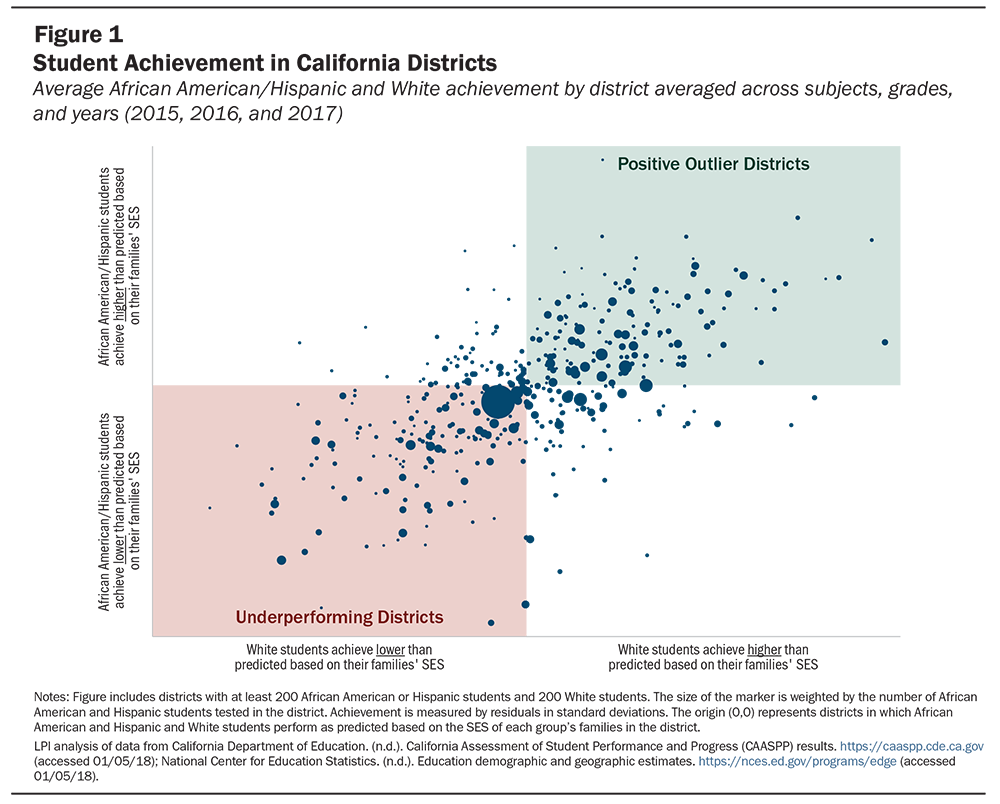California’s Positive Outliers: Districts Beating the Odds

Summary
Despite wide achievement gaps across California between students from different racial and socioeconomic backgrounds, some school districts have excelled at supporting the learning of all their students. This analysis identifies these positive outlier districts—those in which students of color, as well as White students, consistently achieve at higher levels than students from similar racial/ethnic backgrounds and from families of similar income and education levels in most other districts. These results are predicted, in significant part, by the qualifications of districts’ teachers, as measured by their certification and experience. In particular, the proportion of underprepared teachers—those teaching on emergency permits, waivers, and intern credentials—is associated with decreased achievement for all students, while teaching experience is associated with increased achievement, especially for students of color.
Introduction
To succeed in the 21st century, young people need to be able to think critically, collaborate effectively, communicate clearly, solve complex problems, and continue to learn independently throughout their lives. In order to equip the next generation of Californians with these skills, the state adopted new learning standards and assessments that require all students to engage in higher-order thinking and problem-solving. Around the same time, California implemented a new funding and accountability system, the Local Control Funding Formula, which allocated funds based on pupil needs and removed most categorical restrictions on spending.
While these changes were motivated in part by the desire to improve the achievement of historically underserved students, statewide assessments show that achievement gaps in many districts continue to widen. Despite wide achievement gaps across the state between students from different racial and socioeconomic backgrounds, some California school districts have excelled at supporting the learning of all students.
We refer to these California school districts as “positive outliers” because their students are beating the odds. In these districts, students of color, as well as White students, consistently achieve at higher than expected levels, outperforming students of similar racial/ethnic backgroundsSee, e.g., Darling-Hammond, L., & Sutcher, L. (2016, September 19). Equity gap in California: What the new test scores tell us. EdSource.; Tucker, J. (2017, September 27). California releases annual test scores—stagnant results, persistent gaps. SFGate. from families of similar income and education levels in most other California districts. Positive outlier districts appear to have leveraged the state’s updated educational standards, funding, and accountability systems to support students in meeting the more rigorous academic standards.
We conducted an analysis to identify positive outlier districts. These results show, for the first time, which California districts and communities appear to have best supported the academic achievement of African American and Hispanic students, as well as White students, in the first 3 years of the new assessments—the 2015–17 California Assessment of Student Performance and Progress in mathematics and English language arts—controlling for the socioeconomic status of families in each district. We also examined some of the factors associated with their success. (See full report for a discussion of the methodology.)
California’s Positive Outliers
California districts vary significantly in terms of their students’ achievement. Figure 1 shows the variation in the achievement of African American, Hispanic, and White students across California’s 435 school districts with at least 200 African American or Hispanic students and 200 White students. African American, Hispanic, and White students in many districts achieve at higher than expected levels given the socioeconomic conditions for each of those groups in their communities. Observations in the top right quadrant of Figure 1 are considered positive outlier districts because White and African American/Hispanic students achieve at higher than predicted levels relative to their socioeconomic status. California has 156 districts of significant size in which students achieve at much higher than expected levels. In contrast, districts in the lower left quadrant are identified as underperforming because African American, Hispanic, and White students achieve lower than predicted by their socioeconomic status.
We identified 48 districts of significant size in which both African American and White students achieve at higher than predicted levels. (See Figure 2.) We use the “residual” from a regression equation, which expresses the difference between the actual scores for each group of students and those predicted by their socioeconomic status. On our measure, Chula Vista Elementary District is the top district in which both White and African American students perform higher than predicted, with several other elementary districts right behind. San Diego Unified and Long Beach Unified are the largest districts in which both groups significantly outperform expectations. (See Figure 2 and Table 1.)
Approximately 167 California districts have had Hispanic and White students consistently achieve at higher than predicted levels. (See Figure 3 and Table 2.) The small districts of Newhall, Winton, Little Lake Elementary, and Magnolia Elementary are highest performing for both groups. Hawthorne and Palo Verde Union Elementary are high-performing for Hispanics. Chula Vista makes the list once again, as do the larger districts of Long Beach and San Diego.
Predictors of Student Achievement
Next, we examine the factors most strongly associated with the achievement of African American, Hispanic, and White students. After controlling for the socioeconomic status of students’ families and district characteristics (such as size and demographic composition) in our regression analysis, we find that teacher qualifications are the most important school-related predictors of student achievement.
Most significant among these is the preparedness of teachers. We find that the percent of teachers holding substandard credentials is significantly and negatively associated with student achievement. In these districts, for every 10% increase in the percentage of teachers with permit, waiver, or intern credentials, the average achievement for students of color is lower, on average, by approximately 0.10 standard deviations. For White students, every 10% increase in the percentage of teachers teaching on substandard credentials is associated with decreasing their achievement by nearly .07 standard deviations.
In addition, teachers’ average experience level within a district is positively associated with achievement for African American and Hispanic students. Teachers’ salaries, which are typically associated with the quality of teachers recruited and retained, make a positive but not statistically significant difference in achievement.
This finding reflects other research showing that teachers are often considered to be the most important within-school contributors to student achievement.Chetty, R., Friedman, J. N., & Rockoff, J. E. (2014). Measuring the impacts of teachers II: Teacher value-added and student outcomes in adulthood. American Economic Review, 104(9), 2633–2679; Rivkin, S. G., Hanushek, E. A., & Kain, J. F. (2005). Teachers, schools, and academic achievement. Econometrica, 73, 417–458; Rockoff, J. (2004). The impact of individual teachers on student achievement: Evidence from panel data. American Economic Review, 94, 247–252. We recognize that qualities such as teacher preparation and experience are also associated with other variables that influence staff recruitment and retention and may signal broader differentials in teaching and learning conditions. For example, districts in rural areas with less proximity to schools of education and many amenities struggle to recruit and retain teachers, as do under-resourced communities, which often struggle as well to retain strong principals and provide sufficient teaching resources. These places that are difficult for teachers to work in and difficult for students to learn in may feel they need to hire more teachers on substandard credentials because relatively few teachers want to work in the district.Podolsky, A., Kini, T., Bishop, J., & Darling-Hammond, L. (2016). Solving the teacher shortage: How to attract and retain excellent educators. Palo Alto, CA: Learning Policy Institute.
It is also true that districts are differentially focused on recruiting and retaining staff, and that some spend more of their money and effort to recruit and retain a strong teaching staff than others.Podolsky, A., Kini, T., Bishop, J., & Darling-Hammond, L. (2016). Solving the teacher shortage: How to attract and retain excellent educators. Palo Alto, CA: Learning Policy Institute. Whatever the sources of substandard credentials, this finding highlights the importance of teacher characteristics as indicators of both the teaching and learning conditions within a district and as correlates of student achievement.
We explore several other factors and generally find that they are not significantly associated with student achievement in our models when we control for district socioeconomic status and other district characteristics. District size does show a negative influence on achievement, even after controlling for Los Angeles Unified School District, the state’s largest district. Teacher-pupil ratios are not significantly associated with student achievement, after controlling for teacher qualifications. Similarly, after controlling for student-teacher ratios, teacher salary levels, and teacher qualifications, total school spending does not have a statistically significant association with student achievement. This is not surprising, as these variables capture the major elements of total expenditures. Other studies have found that increased district expenditures allocated toward instructionWenglinsky, H. (1997). How money matters: The effect of school district spending on academic achievement. Sociology of Education, 70(3), 221–237. and investments in teacher qualityFerguson, R. (1991). Paying for public education: New evidence on how and why money matters. Harvard Journal on Legislation, 28, 465–498. can be especially effective at raising student achievement.
Conclusion
These analyses indicate that a substantial number of districts in California are outperforming expectations for their students’ achievement on the state’s new, more rigorous assessments, which more fully measure deeper learning. Aside from socioeconomic status of students, a major predictor of student achievement is the preparedness of teachers. Underprepared teachers—those teaching on emergency permits, waivers, and intern credentials—are associated with decreased achievement for all students, especially for students of color.
This is a particularly important finding at this moment in California, where severe teacher shortages have created a large influx of underprepared teachers, which has dramatically increased since 2015. In 2017–18, the Teacher Credentialing Commission authorized more than 12,000 substandard permits and credentials, representing about half of the entering workforce in that year.California Commission on Teacher Credentialing. (2019). Teacher supply in California: A report to the legislature: Annual report 2017–2018. Sacramento, CA: Author. These underprepared teachers are disproportionately assigned to schools serving the largest shares of students of color and students from low-income families throughout the state.Carver-Thomas, D., & Darling-Hammond, L. (2017). Addressing California’s growing teacher shortage: 2017 update. Palo Alto, CA: Learning Policy Institute.
Districts that have been able to avoid the effects of widespread teacher shortages by recruiting and retaining fully prepared teachers are much more likely to produce strong student achievement for African American and Hispanic students as well as for White students. Our results highlight the importance of investing in preparing and keeping quality teachers.
California’s Positive Outliers: Districts Beating the Odds (research brief) by Anne Podolsky, Linda Darling-Hammond, Christopher Doss, and Sean Reardon is licensed under a Creative Commons Attribution-NonCommercial 4.0 International License.
This research was supported by the William and Flora Hewlett Foundation. Core operating support for the Learning Policy Institute is also provided by the Sandler Foundation and the Ford Foundation. We are grateful to them for their generous support. The ideas in this report are those of the authors and not of our funders.
Updated August 29, 2019. Revisions are noted here.

